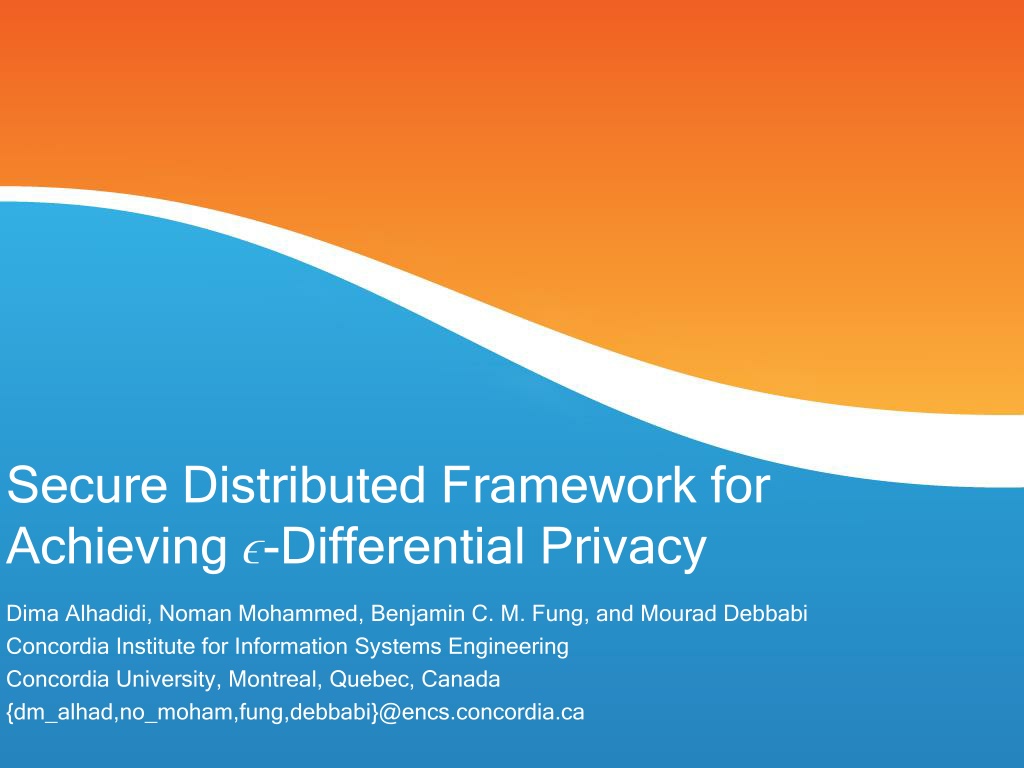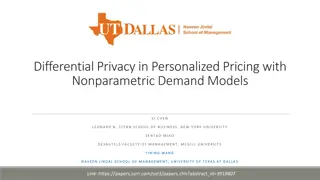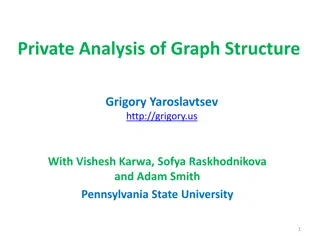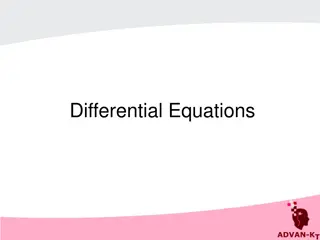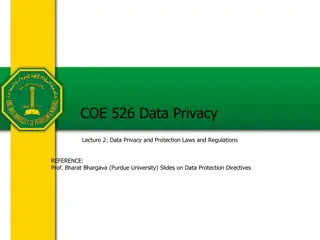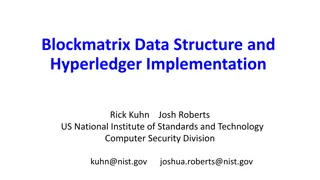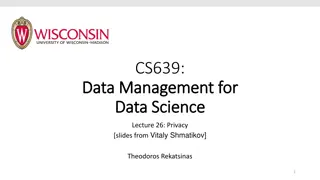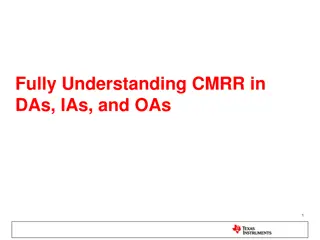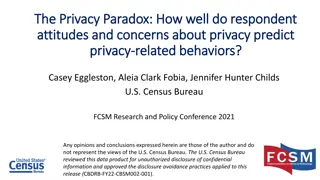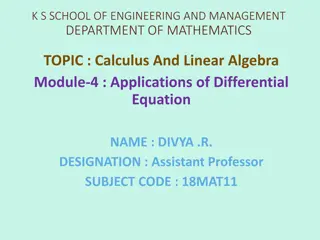Secure Distributed Framework for Achieving Differential Privacy
This research discusses a secure distributed framework for achieving differential privacy, focusing on motivation, problem statement, related work, background, two-party differentially private data release, and performance analysis. The framework aims to address the challenges of anonymization algorithms, data distribution, and privacy preservation in centralized and distributed systems.
Download Presentation

Please find below an Image/Link to download the presentation.
The content on the website is provided AS IS for your information and personal use only. It may not be sold, licensed, or shared on other websites without obtaining consent from the author. Download presentation by click this link. If you encounter any issues during the download, it is possible that the publisher has removed the file from their server.
E N D
Presentation Transcript
Secure Distributed Framework for Achieving -Differential Privacy Dima Alhadidi, Noman Mohammed, Benjamin C. M. Fung, and Mourad Debbabi Concordia Institute for Information Systems Engineering Concordia University, Montreal, Quebec, Canada {dm_alhad,no_moham,fung,debbabi}@encs.concordia.ca
Outline Motivation Problem Statement Related Work Background Two-Party Differentially Private Data Release Performance Analysis Conclusion 6/24/2012 2
Outline Motivation Problem Statement Related Work Background Two-Party Differentially Private Data Release Performance Analysis Conclusion 6/24/2012 3
Motivation Centralized Individuals Data Publisher Anonymization Algorithm Data Recipients Distributed 6/24/2012 4
Motivation Distributed: Vertically-Partitioned ID ID Job Job ID Sex Salary 1 Writer 1 M 30K 2 Dancer 2 M 25K 3 Writer 3 M 35K 4 Dancer 4 F 37K 5 Engineer 5 F 65K 6 Engineer 6 F 35K 7 Engineer 7 M 30K 8 Dancer 8 F 44K 9 Lawyer 9 M 44K 10 Lawyer 10 F 44K 6/24/2012 5
Motivation Distributed: Vertically-Partitioned ID ID Job Job Sex Salary 1 Writer M 30K 2 Dancer M 25K 3 Writer M 35K 4 Dancer F 37K 5 Engineer F 65K 6 Engineer F 35K 7 Engineer M 30K 8 Dancer F 44K 9 Lawyer M 44K 10 Lawyer F 44K 6/24/2012 6
Motivation Distributed: Horizontally-Partitioned ID ID Job Job Sex Sex Age Age Surgery Surgery ID ID Job Job Sex Sex Age Age Surgery Surgery 8 Doctor M 58 Plastic 1 Janitor M 34 Transgender 9 Doctor M 24 Urology 2 Lawyer F 58 Plastic 10 Janitor F 63 Vascular 3 Mover M 58 Urology 11 Mover F 63 Plastic 4 Lawyer M 24 Vascular 5 Mover M 34 Transgender 6 Janitor M 44 Plastic 7 Doctor F 44 Vascular 6/24/2012 7
Motivation Distributed: Horizontally-Partitioned ID ID Job Job Sex Sex Age Age Surgery Surgery 1 Janitor M 34 Transgender 2 Lawyer F 58 Plastic 3 Mover M 58 Urology 4 Lawyer M 24 Vascular 5 Mover M 34 Transgender 6 Janitor M 44 Plastic 7 Doctor F 44 Vascular 8 Doctor M 58 Plastic 9 Doctor M 24 Urology 10 Janitor F 63 Vascular 11 Mover F 63 Plastic 6/24/2012 8
Motivation Distributed: Horizontally-Partitioned ID ID Job Job Sex Sex Age Age Surgery Surgery 1 Janitor M 34 Transgender 2 Lawyer F 58 Plastic 3 Mover M 58 Urology 4 Lawyer M 24 Vascular 5 Mover M 34 Transgender 6 Janitor M 44 Plastic 7 Doctor F 44 Vascular 8 Doctor M 58 Plastic 9 Doctor M 24 Urology 10 Janitor F 63 Vascular 11 Mover F 63 Plastic 6/24/2012 9
Motivation Distributed: Horizontally-Partitioned ID ID Job Job Sex Sex Age Age Surgery Surgery 1 Janitor M 34 Transgender 2 Lawyer F 58 Plastic 3 Mover M 58 Urology 4 Lawyer M 24 Vascular 5 Mover M 34 Transgender 6 Janitor M 44 Plastic 7 Doctor F 44 Vascular 8 Doctor M 58 Plastic 9 Doctor M 24 Urology 10 Janitor F 63 Vascular 11 Mover F 63 Plastic 6/24/2012 10
Motivation Distributed: Horizontally-Partitioned ID ID Job Job Sex Sex Age Age Surgery Surgery 1 Janitor M 34 Transgender 2 Lawyer F 58 Plastic 3 Mover M 58 Urology 4 Lawyer M 24 Vascular 5 Mover M 34 Transgender 6 Janitor M 44 Plastic 7 Doctor F 44 Vascular 8 Doctor M 58 Plastic 9 Doctor M 24 Urology 10 Janitor F 63 Vascular 11 Mover F 63 Plastic 6/24/2012 11
Outline Motivation Problem Statement Related Work Background Two-Party Differentially Private Data Release Performance Analysis Conclusion 6/24/2012 12
Problem Statement Desideratum to develop a two-party data publishing algorithm for horizontally-partitioned data which : achieves differential privacy and satisfies the security definition of secure multiparty computation (SMC). 6/24/2012 13
Outline Motivation Problem Statement Related Work Background Two-Party Differentially Private Data Release Performance Analysis Conclusion 6/24/2012 14
Related Work Data Owner Data Owner Privacy Model Privacy Model Algorithms Algorithms Distributed Differential Privacy Partition- based Privacy Centralized Horizontally Vertically LeFevre et al., Fung et al., etc Xiao et al. , Mohammed et al. , etc. Jurczyk and Xiong, Mohammed et al. Jiang and Clifton, Mohammed et al. Our proposal 6/24/2012 15
Outline Motivation Problem Statement Related Work Background Two-Party Differentially Private Data Release Performance Analysis Conclusion 6/24/2012 16
k-Anonymity Raw patient table Job Sex Age Disease Engineer Male 35 Fever Engineer Male 38 Fever Lawyer Male 38 Hepatitis Musician Female 30 Flu Musician Female 30 Hepatitis Dancer Female 30 Hepatitis Dancer Female 30 Hepatitis 6/24/2012 17
k-Anonymity Quasi-identifier (QID) Raw patient table Disease Job Sex Age Engineer Male 35 Fever Engineer Male 38 Fever Lawyer Male 38 Hepatitis Musician Female 30 Flu Musician Female 30 Hepatitis Dancer Female 30 Hepatitis Dancer Female 30 Hepatitis 6/24/2012 18
k-Anonymity Raw patient table 3-anonymous patient table Job Sex Age Disease Job Sex Age Disease Engineer Male 35 Fever Professional Male [36-40] Fever Engineer Male 38 Fever Professional Male [36-40] Fever Lawyer Male 38 Hepatitis Professional Male [36-40] Hepatitis Musician Female 30 Flu Artist Female [30-35] Flu Musician Female 30 Hepatitis Artist Female [30-35] Hepatitis Dancer Female 30 Hepatitis Artist Female [30-35] Hepatitis Dancer Female 30 Hepatitis Artist Female [30-35] Hepatitis 6/24/2012 19
Differential Privacy D D 6/24/2012 20
Laplace Mechanism D 6/24/2012 21
Exponential Mechanism McSherry and Talwar have proposed the exponential mechanism that can choose an output that is close to the optimum with respect to a utility function while preserving differential privacy. 6/24/2012 22
Outline Motivation Problem Statement Related Work Background Two-Party Differentially Private Data Release Performance Analysis Conclusion 6/24/2012 23
Two-Party Differentially Private Data Release Generalizing the raw data Adding noisy count 6/24/2012 24
Generalizing the raw data Distributed Exponential Mechanism (DEM) 6/24/2012 25
Generalization Distributed Exponential Mechanism (DEM) 6/24/2012 26
Adding Noisy Count Each party adds a Laplace noise to its count . Each party sends the result to the other party. 6/24/2012 27
Two-Party Protocol for Exponential Mechanism Input: 1. Two raw data sets by two parties 2. Set of candidates 3. Privacy budget Output : Winner candidate 6/24/2012 28
Max Utility Function ID ID Class Class Job Job Sex Sex Age Age Surgery Surgery Class Class Max Max Job Job Data Set Data Set 1 N Janitor M 34 Transgender Y Y 3 2 2 1 5 3 N N 1 1 0 1 1 2 2 Y Lawyer F 58 Plastic 5 Blue-collar White-collar Blue-collar White-collar Blue-collar White-collar 3 Y Mover M 58 Urology D1 4 N Lawyer M 24 Vascular 5 Y Mover M 34 Transgender 3 D2 6 Y Janitor M 44 Plastic 7 Y Doctor F 44 Vascular 8 Integrated D1 and D2 D D1 1 6/24/2012 29
Max Utility Function ID ID Class Class Job Job Sex Sex Age Age Surgery Surgery Class Class Max Max Job Job Data Set Data Set 8 N Doctor M 58 Plastic Y Y 3 2 2 1 5 3 N N 1 1 0 1 1 2 9 Y Doctor M 24 Urology 5 Blue-collar White-collar Blue-collar White-collar Blue-collar White-collar 10 Y Janitor F 63 Vascular D1 11 Y Mover F 63 Plastic 3 D2 D D2 2 8 Integrated D1 and D2 6/24/2012 30
Max Utility Function ID ID Class Class Job Job Sex Sex Age Age Surgery Surgery Class Class Max Max Job Job Data Set Data Set 1 N Janitor M 34 Transgender Y Y 3 2 2 1 5 3 N N 1 1 0 1 1 2 2 Y Lawyer F 58 Plastic 5 Blue-collar White-collar Blue-collar White-collar Blue-collar White-collar 3 Y Mover M 58 Urology D1 4 N Lawyer M 24 Vascular 5 Y Mover M 34 Transgender 3 D2 6 Y Janitor M 44 Plastic 7 Y Doctor F 44 Vascular 8 Integrated D1 and D2 8 N Doctor M 58 Plastic 9 Y Doctor M 24 Urology 10 Y Janitor F 63 Vascular 11 Y Mover F 63 Plastic D D1 1 & & D D2 2 6/24/2012 31
Computing Max Utility Function Blue-collar Class Class Max Max Job Job Data Set Data Set Y Y 3 2 2 1 5 3 N N 1 1 0 1 1 2 5 Blue-collar White-collar Blue-collar White-collar Blue-collar White-collar D1 3 D2 8 Integrated D1 and D2 6/24/2012 32
Computing Max Utility Function max=1 Blue-collar Class Class Max Max Job Job Data Set Data Set Y Y 3 2 2 1 5 3 N N 1 1 0 1 1 2 5 Blue-collar White-collar Blue-collar White-collar Blue-collar White-collar D1 3 D2 8 Integrated D1 and D2 6/24/2012 33
Computing Max Utility Function max=1 Blue-collar Class Class Max Max Job Job Data Set Data Set Y Y 3 2 2 1 5 3 N N 1 1 0 1 1 2 5 Blue-collar White-collar Blue-collar White-collar Blue-collar White-collar D1 3 D2 8 Integrated D1 and D2 6/24/2012 34
Computing Max Utility Function max=5, sum=5 Blue-collar Class Class Max Max Job Job Data Set Data Set Y Y 3 2 2 1 5 3 N N 1 1 0 1 1 2 5 Blue-collar White-collar Blue-collar White-collar Blue-collar White-collar D1 3 D2 8 Integrated D1 and D2 6/24/2012 35
Computing Max Utility Function sum=5 White-collar Class Class Max Max Job Job Data Set Data Set Y Y 3 2 2 1 5 3 N N 1 1 0 1 1 2 5 Blue-collar White-collar Blue-collar White-collar Blue-collar White-collar D1 3 D2 8 Integrated D1 and D2 6/24/2012 36
Computing Max Utility Function max=2, sum=5 White-collar Class Class Max Max Job Job Data Set Data Set Y Y 3 2 2 1 5 3 N N 1 1 0 1 1 2 5 Blue-collar White-collar Blue-collar White-collar Blue-collar White-collar D1 3 D2 8 Integrated D1 and D2 6/24/2012 37
Computing Max Utility Function max=2, sum=5 White-collar Class Class Max Max Job Job Data Set Data Set Y Y 3 2 2 1 5 3 N N 1 1 0 1 1 2 5 Blue-collar White-collar Blue-collar White-collar Blue-collar White-collar D1 3 D2 8 Integrated D1 and D2 6/24/2012 38
Computing Max Utility Function max=3, sum=8 White-collar Class Class Max Max Job Job Data Set Data Set Y Y 3 2 2 1 5 3 N N 1 1 0 1 1 2 5 Blue-collar White-collar Blue-collar White-collar Blue-collar White-collar D1 3 D2 8 Integrated D1 and D2 Result: Shares 1 and 2 6/24/2012 39
Computing the Exponential Equation Given the scores of all the candidates, exponential mechanism selects the candidate having score u with the following probability: Shares 1 and 2 6/24/2012 40
Computing the Exponential Equation Taylor Series = = 6/24/2012 41
Computing the Exponential Equation Lowest common multiplier of {2!, ,w!}, no fraction Approximating up to a predetermined number s after the decimal point 6/24/2012 42
Computing the Exponential Equation No fraction 6/24/2012 43
Computing the Exponential Equation First Party Oblivious Polynomial Evaluation Result First Party Second Party Second Party 6/24/2012 44
Computing the Exponential Equation First Party Second Party 6/24/2012 45
Computing the Exponential Equation Picking a random number [0,1] 0 1 0.2 0.7 0.3 0.5 6/24/2012 46
Computing the Exponential Equation Picking a random number [0, ] 0 6/24/2012 47
Picking a Random Number First Party Second Party Random Value Protocol [Bunn and Ostrovsky 2007] Second Party First Party 6/24/2012 48
Picking a Winner 6/24/2012 49
Outline Motivation Problem Statement Related Work Background Two-Party Differentially Private Data Release Performance Analysis Conclusion 6/24/2012 50
